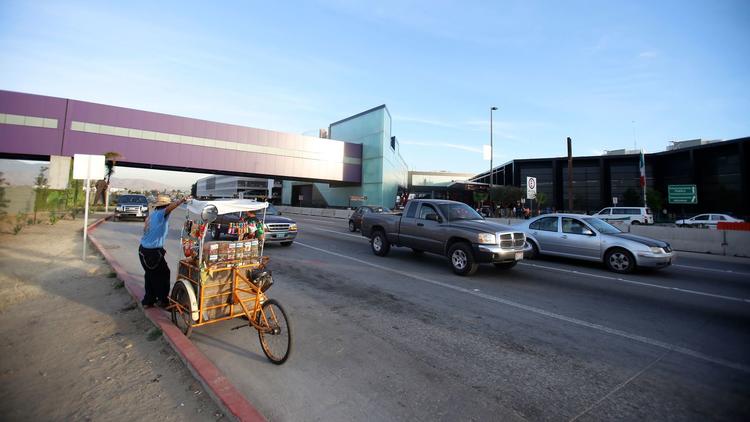President-elect Donald Trump’s call for stepped-up deportations, construction of a continuous wall on the U.S.-Mexico border and changing the terms of trade with Mexico raised alarm among many striving for closer ties between Tijuana and San Diego.
But those who champion the bilateral relationship say their growing collaboration will not wither away under a Trump administration, even amid much uncertainty as to how these proposals will be carried out.
On the contrary, for many the election serves as an opportunity to highlight the numerous family connections, the increasingly intricate business ties, the multiple cultural, environmental and governmental relationships that bind the two cities.
“This is not about chicken little, it’s about life is going to go on,” said Bob Watkins, vice-president of the Cali Baja Bi-National Mega-Region initiative, an umbrella for six economic development groups in California and Baja California. “We’re so inter-dependent, we just need to make sure we’re heard.”
Recent years have seen a growth in interactions at many levels, connections that can be measured with the rising cross-border truck traffic at Otay Mesa and the flow of pedestrians and passenger vehicles through San Ysidro, where more than 90,000 individual crossings each day make it the busiest land port in the Western Hemisphere.
While Trump’s victory “doesn’t bode well in the broader context” for U.S.-Mexican relations, “on the ground here there is an understanding and a working relationship,” said Assemblywoman Toni Atkins Tuesday night, after she was elected to the state Senate. “We know that we are tied to Tijuana, we’re an economic engine as a region.”
San Diego Mayor Kevin Faulconer and Tijuana Mayor Jorge Astiazarán regularly promote their bi-national region. The Smart Border Coalition, made up of government and business leaders on both sides, focuses on the issue of lengthy border wait times that stifle the region’s economic growth. The UC San Diego’s Center for U.S.-Mexican Studies has introduced quarterly Frontera Fridays tours aimed at connecting and educating leaders on both sides of the border.
Twice a year, the San Diego Regional Chamber of Commerce heads a bi-national delegation to lobby in Mexico City and Washington, D.C. for common issues such as cross-border freight rail service and border infrastructure improvements. Its new mission will be promoting the benefits of the North American Free Trade Agreement, which Trump has threatened to re-negotiate or even cancel.
“We’ve just got to double down our efforts,” said Paola Avila, the chamber’s vice president for international business affairs. “Protecting NAFTA has become a huge priority for us, whereas before that wasn’t a concern.”
Tijuana and San Diego were collaborating closely on different fronts in the years leading up to the Sept. 11, 2001 terrorist attacks. But in the ensuing years, as border security grew tighter, “things retrenched,” said José Larroque, a Tijuana attorney and co-chair of the Smart Border Coalition. “I think we sort of lost our way for about a decade. The U.S.became inward focused.”
More recently, collaboration has been picking up again: “We’re here, we have to continue to work together. We’re bound at the hip,” Larroque said. And the region’s growth continues to depend on the fluidity of border crossings, no matter who is president. “From a relationship perspective, things pretty much remain the same locally,” Larroque said.
The collaboration has not only involved local players. In recent years, the Tijuana-San Diego border has also become a showcase for a number of innovative border infrastructure projects negotiated through the U.S. and Mexican federal governments.
One involves a joint agricultural inspection facility in Tijuana opened in January, where armed U.S. and Mexican officers work side-by-side near the Otay Mesa Port of Entry — a ground-breaking arrangement that required extensive negotiation by the two federal governments.
West of the Otay Mesa port of entry is the privately built and operated Cross Border Xpress a tolled pedestrian crossing between San Diego and Tijuana that opened in December. In its first 10 months of operation, more than a million people used the bridge that allows ticketed airline passengers to cross to and from Tijuana’s A.L. Rodríguez International Airport.
The latest effort is Otay East, a port of entry for commercial and passenger vehicles being planned jointly by the U.S. and Mexican governments together with the San Diego Association of Governments and Caltrans. The project, which would be financed through tolls, is a priority of the High Level Economic Dialogue between the U.S. and Mexico that seeks to promote economic growth in both countries. Earlier this year, the two governments signed a statement that called it a “port of entry of the future and a new paradigm for bi-national planning.”
Alan Bersin, assistant secretary and chief diplomatic officer at the Department of Homeland Security, has been involved in the negotiations for all three projects. “Where we are today is a remarkable development of institutions, relationships, trust and confidence among officials, shared ways of seeing border management between the United States and Mexico,” he said in an interview on Wednesday.
Under the new administration, “there will be changes, I have no doubt,” Bersin said, but refrained from speculating on the possibilities.
He urged border communities to join together to make their needs known to federal policy-makers: “San Diego and Tijuana have done a good job of unifying the cross-border approach and now it needs to be expanded,” he said. “Part of the discussion should be the border communities’ need to speak frequently with one voice in Mexico City and Washington. You do that by building coalitions.”
While it created much controversy during the campaign, Trump’s call for a continuous border wall—and having Mexico pay for it—would bring few changes to this westernmost stretch of the border, where extensive fencing already exists.
But the prospect of changes to NAFTA under Trump is generating a measure of alarm. At the Tijuana Innovadora conference on Thursday evening, the issue came up during a talk by José Angel Gurría, a veteran Mexican diplomat who serves as secretary-general of the Organization for Economic Cooperation and Development, an intergovernmental group of 35 member-nations that seeks to stimulate world trade.
Gurría, who helped negotiate NAFTA, called for calm and offered hope: “The San Diego-Tijuana corridor can grow into a motor of shared prosperity between the United States and Mexico,” he told the audience.
At the conference earlier in the day, following a panel on the Tijuana River watershed, San Diego State University professor Paul Ganster considered potential impacts of a Trump administration on the region. “Maybe we can learn something from 9/11, which imposed a lot of new conditions, circumstances, requirements on the border,” said Ganster, who heads the university’s Institute for Regional Study of the Californias.
“With the new administration, we’ll see an examination of everything,” Ganster said. Though “local people get it,” he said, “I’m not sure Congress really understands the border and I’m not sure the new administration does.”
The panel’s Mexican moderator, Carlos de la Parra, was also uncertain about the path ahead.
“Right now, for me at least, Trump is an unknown variable,” said de la Parra, a professor at the Tijuana-based think tank Colegio de la Frontera Norte. He also serves on the board of directors of the North American Development Bank and the Border Environment Cooperation Commission, institutions created under NAFTA to address border environmental issues.
“I don’t sympathize with the man,” he said, “but I don’t know him as a president. Is he going to come out with wise decisions based on good, sound advice?”





